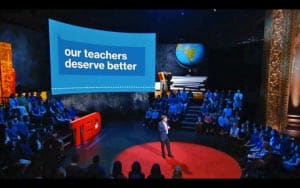This article shows you how to use TED Talks to improve your English, how they can be used in the classroom and suggests 10 great talks to use in the English classroom.
TED is a series of informative, educational, inspiring and sometimes jaw-dropping talks that present ‘Ideas Worth Spreading’. Ted has attracted many of the world’s most important thinkers such as Larry Page, Bill Clinton, Bill Gates, Ken Robinson, and a few winners of the Nobel Prize.
There is an emphasis on informing, educating and opening people’s eyes to new ideas, making them perfect for the classroom. Students love these talks and really appreciate it when you take the time to make a lesson out of them. Teenagers, being the ‘YouTube generation’, also find them highly engaging and motivating. They come with transcriptions in most common languages, allowing students to read what they have listened to in English or their native tongue.
This post will list 10 TED talks I have found work particularly well in the classroom. I will also outline how students could use TED to improve their English at home and how teachers can use them in class.
How Students Can Use TED at Home

TED Talks for students provide an engaging context from which they can autonomously improve their English at home. There are thousands of videos to choose from, so there should always be something of interest. They can help students improve, not only their listening skills but also improve their pronunciation, vocabulary, grammar and writing.
- Listening
This is the obvious one, but students should be encouraged to listen ‘actively’. Ask students to look at the title before they listen and try to predict what they are going to hear. They can also pause at different points and try to guess what they will hear next. Another useful exercise is ‘micro-listening’ where they rewind and listen again and again to any sentences they didn’t quite get until they fully understand, thereby getting used to connected speech and any other barriers that might prevent comprehension.
- Pronunciation
‘Micro-listening’ can also be used to help students produce sentences. Identify a few sentences that caused the listener trouble and identify elements of connected speech, weak sounds and or difficult phonemes. A comparison with the transcripts should highlight important differences between written and spoken English. Students can then practice reproducing these features at home.
- Vocabulary
Learners listen for unfamiliar words and then try to guess the meaning from context. They can also look at the transcripts for extra help. Students can then note down their new words together with definitions, synonyms, antonyms and example sentences.
- Grammar
Students could be encouraged to think about the grammar used. What verb tenses were used and why? How did the speaking use sequencing words? How did they use discourse markers? What phrases did they use to make their points or persuade the audience?
- Writing
Below every TED video is a comments section where people discuss the video and the issues that came up in the video. Students can enter these debates and practice their writing at the same time.
How Teachers Can Use TED Talks in Class

Every TED Talk is different and they can, therefore, be exploited in a variety of different ways. Below are a few suggestions:
- Pre-Listening Task
Ask some questions about the title. What do you think the speaker is going to say?
Example: Ken Robinson- How Schools Kill Creativity.
Do schools teach creativity?
Which subjects are creative and which are not?
How do schools kill creativity?
Is it the teacher’s fault?
Alternatively, you could give them some key vocabulary from the talk and ask them to predict what is going to be said based on the keywords.
- First Listen
Ask students to listen and check if their ideas match those in the video. If not, how are they different?
You could also give them the transcript with the keywords missing and ask them to insert them as they listen.
- Focus on Lexis, Grammar or Functional Language
I normally ask students to note down any words or phrases they don’t understand and then either watch again or read the transcript to try to guess the meaning from context. Students should then discuss their unknown words and expressions with other students to see if anyone can help them and the teacher clarifies at the end.
This approach can also be used for verb tenses or functional language. For example, how did the speaker use sequencing language? What phrases did they use to try and prove their point? How many times was the present perfect used and why?
- Post Listening Task
Give students a task that encourages them to use the language you focused on in the previous stage. Here are some examples:
- Interview the speaker– think of questions you might ask the speaker based on what you have heard. Role play as a journalist and speaker. Students should try to use phrases used to persuade the journalist or make a point.
- Explain what you mean– give each student the definition of a difficult word or concept brought up in the video and students mingle asking each other to explain what they mean.
- Debate– Write a few controversial statements of the board and divide students in to ‘for’ and ‘against’ teams. They should work together to think of how they are going to justify their points and then have a debate.
- Write a review– What did they think of the TED talk? Did they agree or disagree with the points made? Was the speaker convincing? Did they find it inspiring?
- Presentation– Write and present your own talk on a similar topic.
- Explain to a lower class– How would you explain the ideas in simple terms to a class a level below you?
I hope you have found these ideas useful and if you have any other ways to use TED Talks in class, please let us know below.
The best way to keep up to date with posts like this is to like us on Facebook.
Here are my top 10 TED Talks:
Sir Ken Robinson – Do Schools Kills Creativity?
Jamie Oliver – Teach Every Child About Food
Al Gore – Averting the Climate Crisis
Hans Rosling – The Best Stats You’ve Ever Seen
David Christian – The History of our World in 18 Minutes
Jay Walker – The World’s English Mania
Edward Snowden – Here’s How We Take Back the Internet
Nigel Marsh – How to Make Work Life Balance Work
Bill Gates – Mosquitos, Malaria and Education
Sugata Mitra – Build a School in the Cloud

